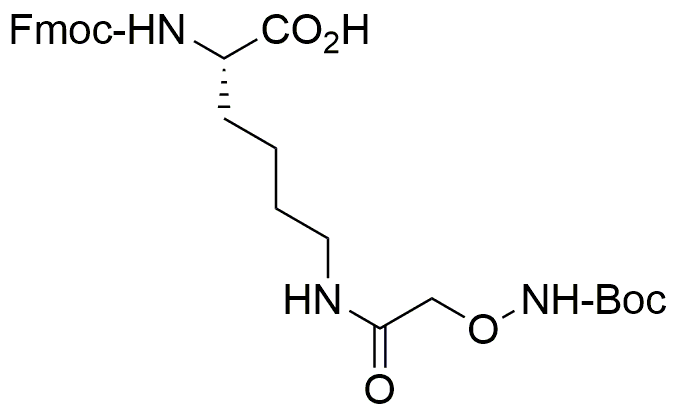Na -Fmoc- Nb -(N-Boc-amino-oxyacetyl)-L-lysine is widely utilized in research focused on:
- Peptide Synthesis: This compound serves as a key building block in the synthesis of peptides, allowing researchers to create complex structures for various biological studies.
- Drug Development: Its unique functional groups facilitate the development of novel therapeutics, particularly in targeting specific biological pathways, enhancing drug efficacy.
- Bioconjugation: The compound is ideal for bioconjugation applications, enabling the attachment of biomolecules to surfaces or other molecules, which is crucial in diagnostics and therapeutic delivery systems.
- Protein Modification: It is used to modify proteins for better stability and activity, making it valuable in enzyme engineering and protein therapeutics.
- Research in Cancer Biology: The compound's ability to selectively target cancer cells is being explored, providing potential pathways for more effective cancer treatments.
General Information
Properties
Safety and Regulations
Applications
Na -Fmoc- Nb -(N-Boc-amino-oxyacetyl)-L-lysine is widely utilized in research focused on:
- Peptide Synthesis: This compound serves as a key building block in the synthesis of peptides, allowing researchers to create complex structures for various biological studies.
- Drug Development: Its unique functional groups facilitate the development of novel therapeutics, particularly in targeting specific biological pathways, enhancing drug efficacy.
- Bioconjugation: The compound is ideal for bioconjugation applications, enabling the attachment of biomolecules to surfaces or other molecules, which is crucial in diagnostics and therapeutic delivery systems.
- Protein Modification: It is used to modify proteins for better stability and activity, making it valuable in enzyme engineering and protein therapeutics.
- Research in Cancer Biology: The compound's ability to selectively target cancer cells is being explored, providing potential pathways for more effective cancer treatments.
Documents
Safety Data Sheets (SDS)
The SDS provides comprehensive safety information on handling, storage, and disposal of the product.
Product Specification (PS)
The PS provides a comprehensive breakdown of the product’s properties, including chemical composition, physical state, purity, and storage requirements. It also details acceptable quality ranges and the product's intended applications.
Certificates of Analysis (COA)
Search for Certificates of Analysis (COA) by entering the products Lot Number. Lot and Batch Numbers can be found on a product’s label following the words ‘Lot’ or ‘Batch’.
Numéro de catalogue
Numéro de lot/série
Certificates Of Origin (COO)
This COO confirms the country where the product was manufactured, and also details the materials and components used in it and whether it is derived from natural, synthetic, or other specific sources. This certificate may be required for customs, trade, and regulatory compliance.
Numéro de catalogue
Numéro de lot/série
Safety Data Sheets (SDS)
The SDS provides comprehensive safety information on handling, storage, and disposal of the product.
DownloadProduct Specification (PS)
The PS provides a comprehensive breakdown of the product’s properties, including chemical composition, physical state, purity, and storage requirements. It also details acceptable quality ranges and the product's intended applications.
DownloadCertificates of Analysis (COA)
Search for Certificates of Analysis (COA) by entering the products Lot Number. Lot and Batch Numbers can be found on a product’s label following the words ‘Lot’ or ‘Batch’.
Numéro de catalogue
Numéro de lot/série
Certificates Of Origin (COO)
This COO confirms the country where the product was manufactured, and also details the materials and components used in it and whether it is derived from natural, synthetic, or other specific sources. This certificate may be required for customs, trade, and regulatory compliance.


